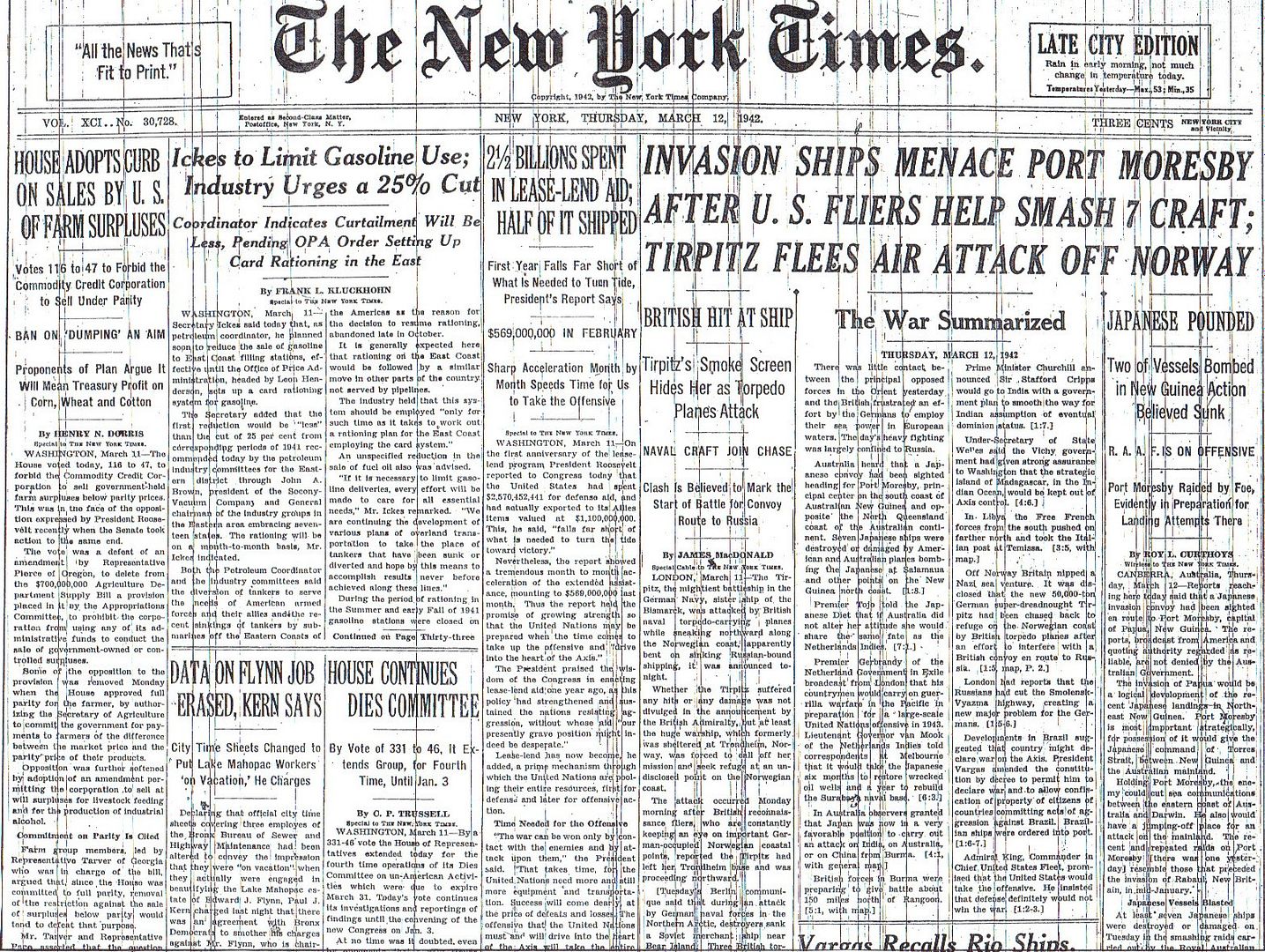
Posted on 03/12/2012 4:33:30 AM PDT by Homer_J_Simpson

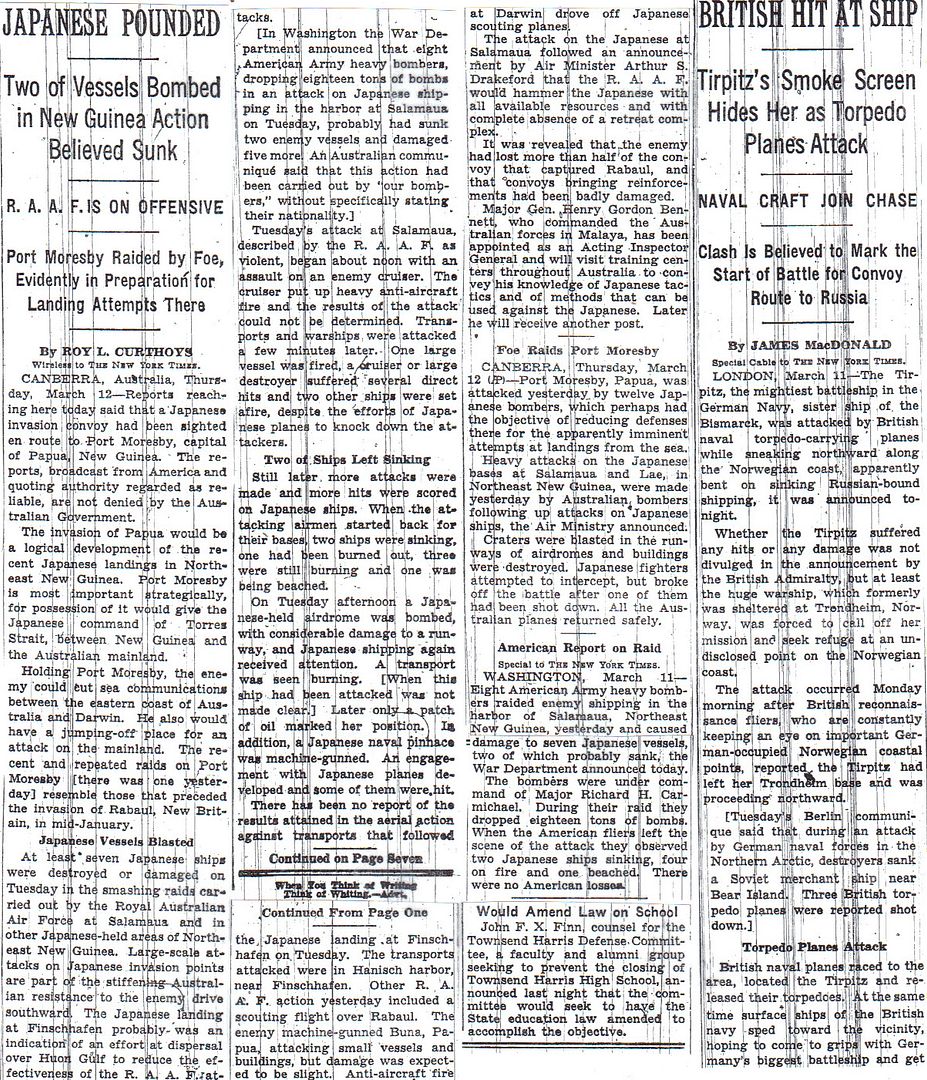
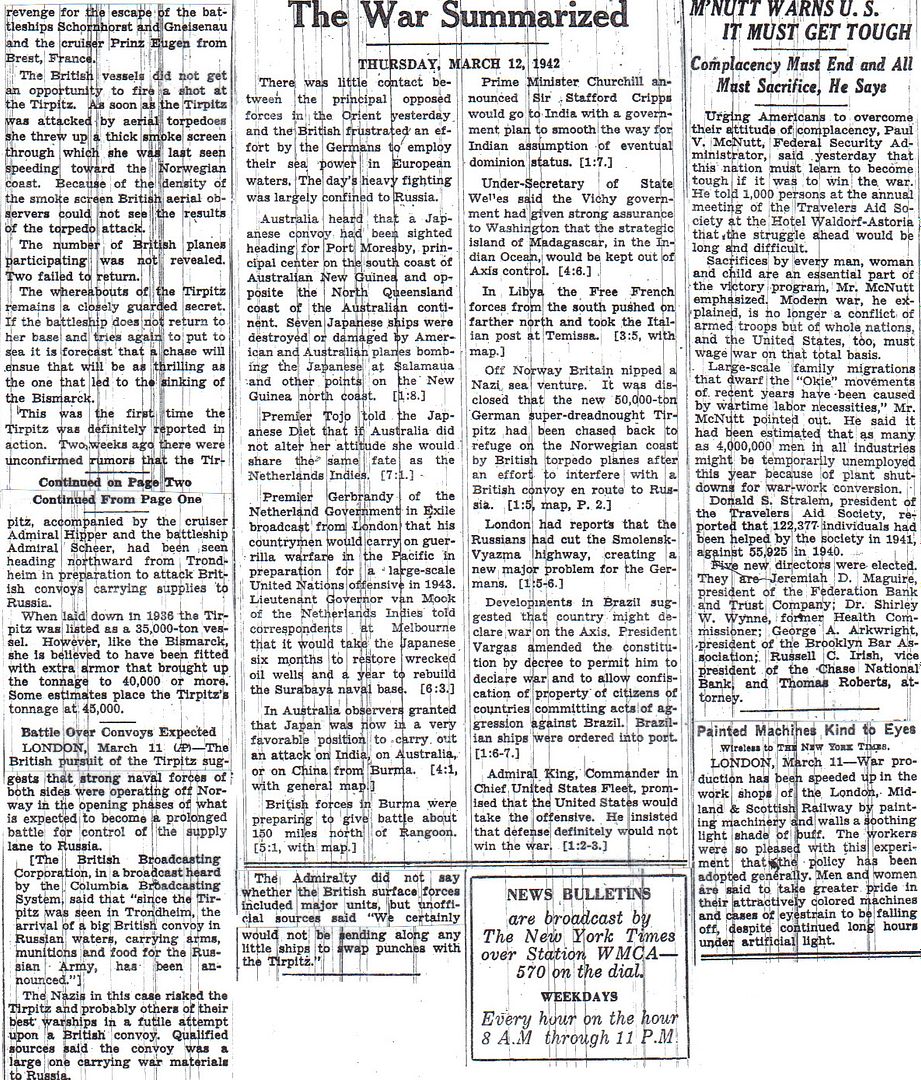
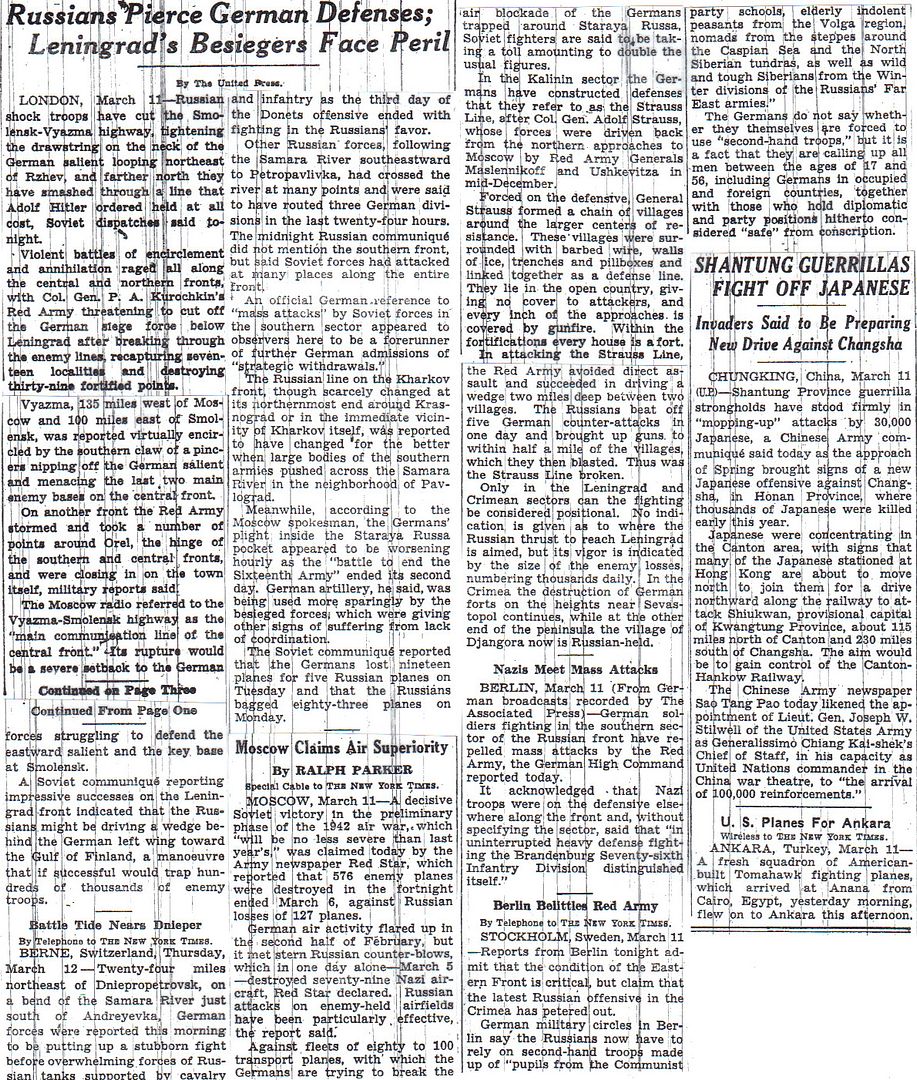
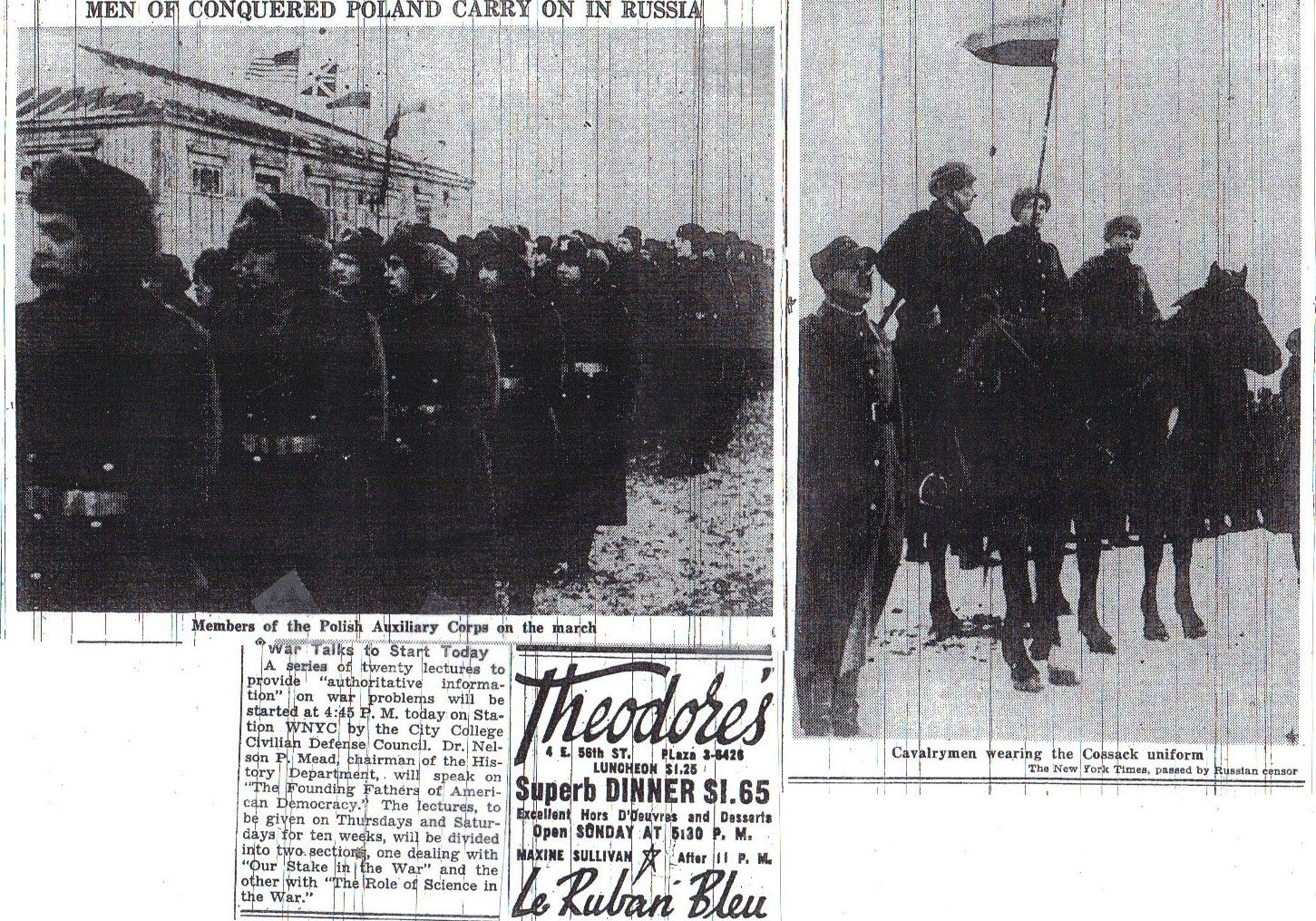
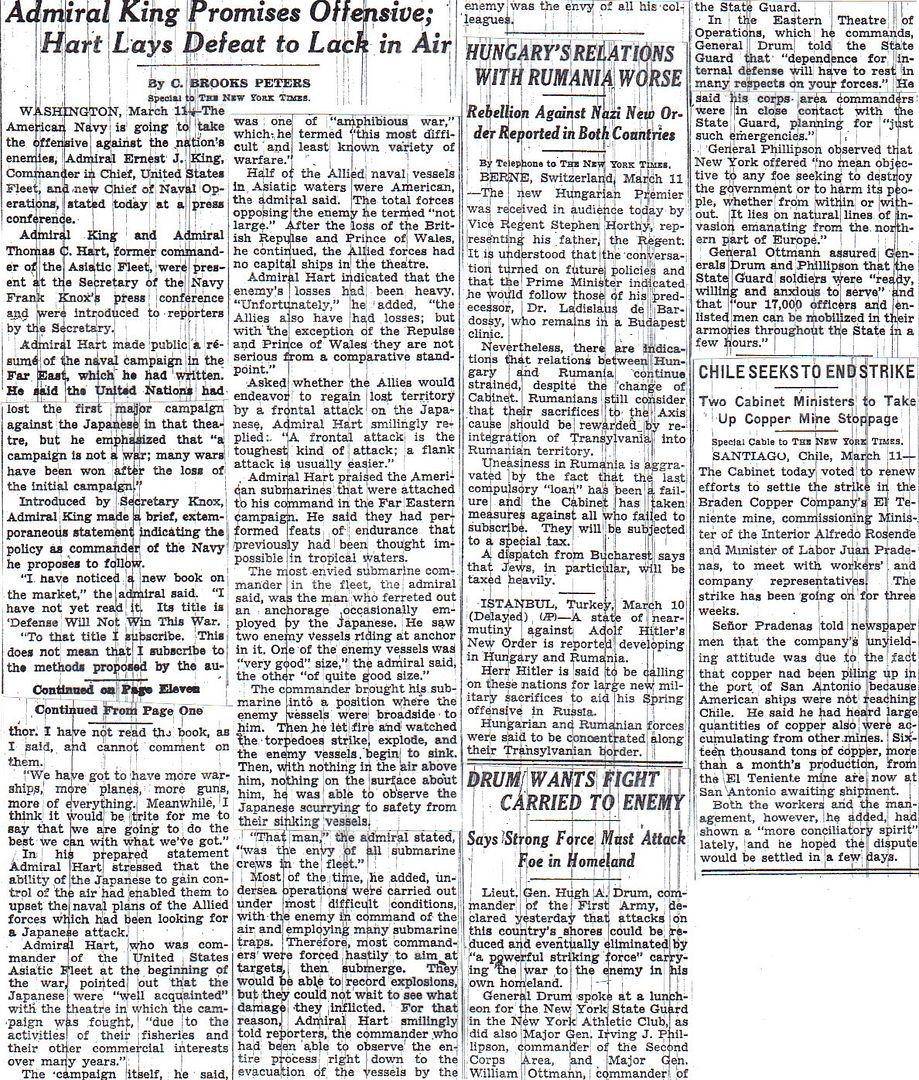

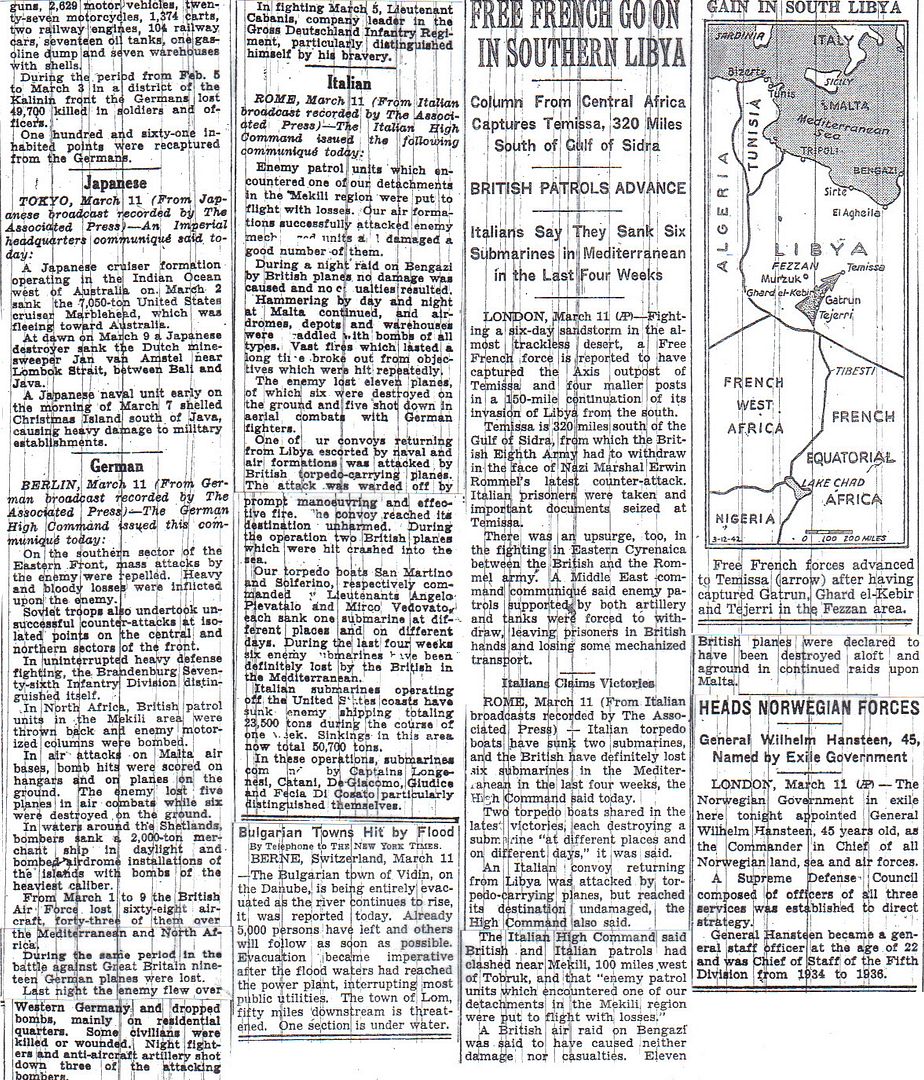
http://www.onwar.com/chrono/1942/mar42/f12mar42.htm
Dutch forces surrender to Japanese
Thursday, March 12, 1942 www.onwar.com
Propoganda poster exhorts the Dutch to free the East IndiesIn the Dutch East Indies... Japanese accept the formal surrender of the Dutch forces. Units of the Japanese Imperial Guard land in northern areas of Sumatra.
In the South Pacific... On New Caledonia, American troops land to garrison the island. These forces include the first operational “Seabees.”
On the Solomon Islands... The Japanese complete the conquest of the islands.
http://homepage.ntlworld.com/andrew.etherington/frame.htm
March 12th, 1942
FRANCE: During the night of the 12th/13th, an RAF Bomber Command Hampden flies a leaflet mission. (Jack McKillop)
GERMANY: Tonight RAF Bomber Command sends 251 aircraft to attack Essen. During the night of the 12th/13th, RAF Bomber Command attacks Emden and Kiel. Twenty Wellingtons and 20 Whitleys are dispatched to Emden; 22 bomb with three Whitleys lost but bombing photographs indicate that the nearest bombs were 5 miles (8 kilometres) from the target. At Kiel, 68 Wellingtons are dispatched to attack the Deutsche Werke U-boat yard; 53 aircraft bomb and reports from Kiel indicate that the port area was successfully bombed, with damage in the Deutsche Werke and the Germania Werft yards, both building U-boats, and in the naval dockyard. Casualties are listed as 12 killed and 21 injured but it is not known whether service personnel were included. Five Wellingtons are lost over Kiel. In the final mission of the night, 16 aircraft lay mines off German ports. (Jack McKillop)
U-612 commissioned. (Dave Shirlaw)
NORWAY: The Tirpitz returns to Trondheim after a six-day sortie, during which there was no action against Convoy PQ-12.
LITHUANIA: Ten Soviet parachutists land near Birzai to commit sabotage. They are seen, chased and shot, and all their equipment, including a radio transmitter, seized by German forces. (Jack McKillop)
U.S.S.R.: Soviet submarine SC-210 lost near Cape Shabler after 12 March 1942. Possibly by UMA type mine of S-15 Romanian minefield. (Dave Shirlaw)
INDIA: Three transports arrive at Karachi after sailing from Australia. Aboard the three ships are the ground echelons of the USAAF’s 7th Bombardment Group (Heavy) and 88th Reconnaissance Squadron (Heavy) arriving from Australia and the 16th and 25th Pursuit Squadrons (Interceptor), 51st Pursuit Group (Interceptor) from the U.S. Cargo aboard the ships includes ten crated P-40s. The 51st Pursuit Group’s P-40s had been aboard the seaplane tender USS Langley (AV-3) when she was sunk on 27 February. (Jack McKillop)
ANDAMAN ISLANDS: The garrison (a British company and a Gurkha battalion) of this group of islands in the Bay of Bengal is withdrawn, since the loss of Rangoon, Burma, makes it unfeasible to maintain this seaplane base. (Jack McKillop)
BURMA: The Burma Army establishes headquarters at Maymyo. (Jack McKillop)
CHINA: Chuck Baisden notes in his journal:
Flew from Kunming, China to Magwe, Burma on a Chinese DC-2 with 20 other support people from the 3rd Squadron AVG. Set up 2 water cooled .30 calibre Browning machine guns in slit trenches outside our operations tent. They were antiques and somebody said they had come of the USNavy Gunboat PANAY the Japs had bombed and sunk. Went to our quarters some distance from field. Area here very desert like. (See more at Chuck’s website)
JAPAN: Japanese Prime Minister General TOJO Hideki urges Australia to submit to Japanese rule or face an invasion like the recently conquered Dutch East Indies. (Jack McKillop)
COMMONWEALTH OF THE PHILIPPINES: Three-quarters of the Americans and Filipinos troops defending Bataan and Corregidor now have major health problems. An estimated 500 to 700 per day are coming down with malaria and dysentery is rampant from drinking tainted water. Meanwhile, the Japanese are bringing in fresh infantry and artillery units from China. (Jack McKillop)
During the night of the 12th/13th, the four motor torpedo (PT) boats carrying General Douglas MacArthur, Commanding General U.S. Army Forces, Far East, his family, Rear Admiral Francis W. Rockwell, Commandant Sixteenth Naval District, and their staffs from Luzon to Tagauayan Island in the Cuyo Group became separated. PT-32 could only use two of its three engines and the other boats had to stop from time to time to clean gasoline strainers. The first boat to arrive at Tagauayan was PT-34 at 0930 hours, two hours late; in the late afternoon, PT-41 and PT-42 arrive in the cove from other islands where they had hidden during the morning hours. PT-35 was missing. Because of the condition of PT-32, the passengers on this boat were divided between the other two boats and these two refuelled using fuel drums carried as deck cargo. The crew of PT-32 was ordered to remain at Tagauayan to await the arrival of the submarine USS Permit (SS-178) and PT-35 and give directions to the captains of both vessels and then the PT-32 could get underway for Panay Island to obtain fuel. At 1800 hours, PT-34 and PT-41 get underway for Cagayan on Mindanao Island. (Jack McKillop)
NETHERLANDS EAST INDIES: On Java, the senior American, Australian and British officers sign a formal surrender document with the Japanese at their headquarters in Bandoeng. (Jack McKillop
NEW CALEDONIA: U.S. Army troops (Brigadier General Alexander M. Patch) land on New Caledonia Island to establish a base at Nouméa. The Army unit is Task Force 6814 consisting of 17,500 men of the 51st Infantry Brigade headquarters and the 132d and 182d Infantry Regiments plus supporting units. Their task is to protect this French colony from Japanese expansion. These American units will become the Americal Division in May 1942. (Jack McKillop)
One of the soldiers landing that day was Bill McLaughlin. He writes, “We had been about 37 days from Brooklyn, New York, to Melbourne, Victoria, Australia, and then about a week or ten days in Bendigo, Victoria, 40 miles (64 kilometres) inland from Melbourne. Back on the ship for another ten days to New Caledonia. It was found that the harbour was too shallow to allow our ship to dock, and we had to go over the side into small boats to take us ashore. There, we were marched through the streets (sea legs and all), and another long haul out to our first bivouac area, and a horde of mosquitoes. Many years later, writing a native of Nouméa, Henri Daly, I mentioned that the sullen faces we saw all thru our march in Nouméa, showed most of them were pro Vichy French. He wrote back, ‘Oh, Bill, did you ever think how most of the adults felt seeing some 15,000 lusty American youth, coming into our small country?’ I still think I was right..the next month we saw the countrymen moving on to Nouméa, in protest with their rifles, and driving out the Vichys.” (Bill McLaughlin, Americal Division)
U.S.A.: President Franklin D. Roosevelt designates Admiral Ernest J. King to serve as the Chief of Naval Operations, as well as the Commander-in-Chief, United States Fleet to which he was appointed on 30 December 1941. King replaces Admiral Harold R Stark as Chief of Naval Operations (CNO) effective 26 March. More...
Minesweeper USS Skylark launched.
Corvette USS Ready commissioned. (Dave Shirlaw)
BRAZIL:
President Vargas issued a decree ordering the confiscation of up to 30% of the funds of Axis nationals in Brazil. There were anti-Nazi demonstrations against German shops and establishments in Rio de Janeiro. The confiscation was ordered to guarantee compensation for the ships that had been sunk. (Dave Shirlaw)
ATLANTIC OCEAN: A U.S. merchant vessels is sunk and two others damaged by German submarines: (1) An armed tanker is torpedoed and irreparably damaged by U-158 about 85 miles (137 kilometres) east of Myrtle Beach, South Carolina, U.S.A.; and (2) U-126 torpedoes two unarmed freighters off the coast of Cuba, sinking the first about 100 miles (161 kilometres) off Camaguey Province, and damaging the second about 10 miles (16 kilometres) off Cape Guajaba. (Jack McKillop)
The first British armed trawlers sent to augment U.S. Navy patrol force efforts off the German submarine-plagued Eastern Seaboard, HMS Wastwater and HMS Le Tigre, begin patrol operations in the Third Naval District waters. They are assigned duties off Atlantic City and Barnegat, New Jersey, U.S.A. (Jack McKillop)
At 0611, the unarmed and unescorted SS Olga was hit by one torpedo from U-126 about 20 miles north of Nuevitas Light, Cuba in the Old Bahama Channel, while steaming on a nonevasive course at 10.5 knots. The torpedo struck on the port side at the #4 hold, destroying the fireroom bulkhead, blowing away the #4 hatch cover and wrecking the wheelhouse and radio room. A lookout had spotted the torpedo wake but it was too late to take avoiding action. The crew of eight officers and 25 crewmen abandoned ship in one lifeboat and two rafts, while the ship stopped and sank at 0640. The first mate Arthur Wilder was picked up by the U-boat, questioned and was then allowed to swim to the nearest raft containing three other men. When the U-boat got underway, its wake swamped the raft and washed the men from it. The second cook died in the water from shock and exposure. The survivors were picked up by a US Naval craft and taken to Guantanamo Bay, Cuba.
The unarmed and unescorted SS Texan was on a nonevasive course, when she was hit at 0234 by a torpedo which struck the port side bulkhead between the #6 and #7 holds. About five minutes later U-126 shelled the ship in an attempt to destroy the radio shack. The vessel was hit by four rounds but had successfully send SOS messages. Within ten minutes after the hit, ten officers and 37 men had launched two lifeboats. After 13 minutes the ship sank and both boats capsized due to the suction (three officers and six men perished). Ten men righted one lifeboat at daybreak and they picked up later 28 other survivors. About 16h00 a plane of the US Navy passed the survivors several times without spotting them. At 05h30 on 13 March the lifeboat was spotted by the Cuban fishing boat Yoyo approximately 15 miles WSW of the sinking position and was towed to Nuevitas, Cuba arriving there at 1050. The master Robert Hugh Murphy later commanded the Coloradan, which was sunk on 9 October 1942 by U-159 (Witte).
At 1536, U-578 fired a spread of two torpedoes at the unescorted SS Ingerto and one of them struck after 1 minute 11 seconds, causing her to sink quickly. The ship had been reported missing, after she was last seen on 12 March in approx. 44°30N/49°30W and was never heard from again. (Dave Shirlaw)
U.S.A.: Lindbergh offers his services to Reuben Fleet of Consolidated Aircraft at a salary of not more than $10,000 a year. Fleet had offered $100,000 a year initially to build a research centre anywhere in the southwestern USA. Fleet is enthusiastic but two weeks later the offer is withdrawn. Again, companies with government contracts are afraid. (Jack McKillop)
Albert Monmouth Jones is promoted to major general (temporary) in the United States Army. (Greg Kelley)
President Franklin D. Roosevelt signs an executive order combining the duties of Commander in Chief U.S. Fleet and the Chief of Naval Operations (CNO). Admiral Ernest J King, Commander-in-Chief U.S. Fleet, is designated to replace Admiral Harold R Stark as Chief of Naval Operations (CNO) effective 26 March. (Jack McKillop)
Disclaimer: Opinions posted on Free Republic are those of the individual posters and do not necessarily represent the opinion of Free Republic or its management. All materials posted herein are protected by copyright law and the exemption for fair use of copyrighted works.